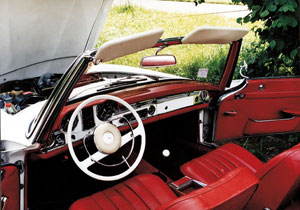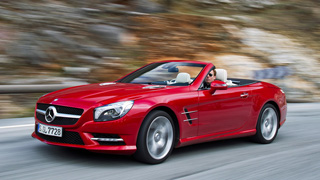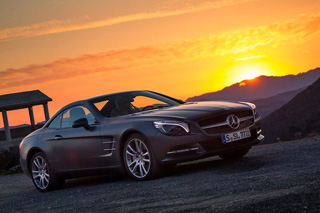Test drive Mercedes Benz SL-class R231 since 2012
Hour "Pagodes"
 It is a little sorry that the roofs on the occasion of a summer test drive were removed from cars. It is not very heavy, the roof, only 80 kg. It was because of its unusual form Mercedes-Benz W113 that Pagoda was named.
It is a little sorry that the roofs on the occasion of a summer test drive were removed from cars. It is not very heavy, the roof, only 80 kg. It was because of its unusual form Mercedes-Benz W113 that Pagoda was named. It is good to start the study with the opening! Let it be small and lies on the surface still charges with optimism. In fact, it was worth looking at the reference book on the classic Mercedes to find out the obvious: on the famous pagoda, which was 40 years old this year, front discs were installed for the first time in the history of the company. British, Girling, with a diameter of 250 mm. The rear ones are still drum, with iron sleeves, tightly fixed in ribbed aluminum casing. This design was tested even in pre -war races of a large prize.
The main surprise was the opportunity to make an introductory trip on the Mercedes-Benz W113 pagod, and even compare the modification of 230SL early release from the 280SL of the last series.
Which of those interested in the car history did not dream of ride in this small, length of only 4285 mm, relatives! It’s great that neither the then chief designer Daimler-Benz Karl Wilfert, nor the head of the research department of Rudolf Ulenhut rose a hand to pull out the car! After all, such a proposal was received from Beli Bellenya, the Mercedes Guru on passive security, and the chief designer of the passenger department of Joseph Miller was inclined to an elongated option. And at that time, a similar car drew a marriage at that time at that time. One trip in the pagoda is enough to understand the reason for the thoughts of the leadership: you have to do one thing or hold on so as not to fall out, or to remain a stake on the sidelines.
One such inconvenient class six months after the debut of Pagoda at the 1963 Geneva Motor Show remained in the catalogs of a grandiose, delicious 300SL. He was a real outrage of the minds, and not even because he dreamed of every boy of the capitalist world in the company herself around this car was conducted busy disputes.
 Recall that we are talking about the development of the wing of the seagull of 1953 of the model year (motor #11, 2001). At that time, the industry of European countries has not yet fully recovered after the war Europe as before, I was dragging forward by America. The key to prosperity Mercedes-Benz was the appearance of a kind of producer in the States, Maxi Hofman. He pushed the 300SL model to the American market, the class at its base and the compact class of 190SL. From the technical side, this model did not represent anything special, but she repeated the form of a relative. In the history of Mercedes-Benz, this was perhaps the first case of creating a car under the influence of not engineering motivation, but marketing.
Recall that we are talking about the development of the wing of the seagull of 1953 of the model year (motor #11, 2001). At that time, the industry of European countries has not yet fully recovered after the war Europe as before, I was dragging forward by America. The key to prosperity Mercedes-Benz was the appearance of a kind of producer in the States, Maxi Hofman. He pushed the 300SL model to the American market, the class at its base and the compact class of 190SL. From the technical side, this model did not represent anything special, but she repeated the form of a relative. In the history of Mercedes-Benz, this was perhaps the first case of creating a car under the influence of not engineering motivation, but marketing. Keeping two relatives in the production program at once at that time was invoice. It was necessary to decide in which direction to move on: whether it is mainly to work on the prestige of the brand, releasing a super-powerful model for professional athletes, or to prefer a car for the general public, not fast enough to involve his lord owner in a truly unpleasant story.
Just imagine all the drama of the situation in which the Mercedes are found: the passion for races and the need to observe new requirements for passive safety and marketing considerations are mixed here. And the market research (at that time Daimler-Benz partnership in America with Studebaker-Packard Corp.) Showed that capricious customers want a power steering, automatic box and good music.
The scales bowed in favor of the second option after a series of terrible accidents that occurred in the second half of the 50s with powerful sports cars. After the tragedy in Le-Man, the Mercedes-Benz for a long time left large sports 300SL lost racing advertising support. In addition, in the main, American, market, the public movement for the safety of vehicles was gaining strength. They made a Solomon decision: to create a car that can warm up the blood, and at the same time does not require special management skills.
Looking at W113, I can’t believe that it all began in September 1962. Nothing in its simple, restrained contours does not indicate kinship with the pompous and massive Mercedes of other models. Having lost the W113 emblem, and he would immediately be accepted for one of the conservative English sports cars. And suddenly such a trick is a concave roof! (By the way, several patents were received on it for the authorship of Karl Wilfert, white lady and marriage fields.) A pagoda roof, only not removable, almost became a sign of the entire Mercedes-Benz passenger family and even buses. This profile of the top found many advantages: the power beams of increased cross section were placed in the rise in the sides of the side, through them it was possible to skip the ventilation ducts. Both the windows and doorways became more. With the bus, it was more interesting from the roof, the traditional place of baggage in European buses, suitcases did not fall. It is interesting that no one was interested in the fact that the roof of this form helps to reduce the air resistance to this thought Mercedes came again in the mid-80s.
However, it's time to get down to business. The turning of the key and under the hood comes to life in a row upper six M127 from the W111 sedan highly efficient short-term injector engine, theoretically (how much time has passed!) Ready to disperse the baby-waterster to 200 km/h. The emergence of versions 250SL (1965) and 280SL (1968) with their new M129 and M130 engines, which, instead of four, had seven crankshaft supports and instead of three to ten counterweights, is difficult to explain if you compare these machines with the very first pagoda according to dynamic characteristics. All the same 200 km/h and 11 seconds to hundreds. Or 195 km/h, if in return a four-speed box, the car itself was equipped with a four-speed automatic machine. The only reasonable reason: new, more complex motors had and an enlarged threeth service interval of 10,000 km.
To achieve from 230SL with a mechanical box of fast overclocking, you have to sacrifice silence and spin the engine to a screech at each step. True, in the later versions, the developers brought the gear rates a little closer, but did not explain why it was necessary to start a series with the number of 4.42 in the first gear, when on a heavier Sedan W111 at a lower power, they completely cost 3.64.
 The late version on the test turned out to be an automatic transmission and brought other sensations. The selector from position P must be translated forward, not backward. The cramped backstage on the sides is endured by a pretty worn nylon that this peculiar Mercedes protection from the fool really worked. It would not be redesigned and not to leave the lever on the neutrals in return for the nest 4. If you push the lever to the number 2 and press the pedal to the floor, the car will shoot, like a carriage on the American hills. Blocks, of course, are intended mainly for mountain driving. And with ordinary touching, it first follows a tangible push, and then the machine accelerates quite smoothly, counting the gear.
The late version on the test turned out to be an automatic transmission and brought other sensations. The selector from position P must be translated forward, not backward. The cramped backstage on the sides is endured by a pretty worn nylon that this peculiar Mercedes protection from the fool really worked. It would not be redesigned and not to leave the lever on the neutrals in return for the nest 4. If you push the lever to the number 2 and press the pedal to the floor, the car will shoot, like a carriage on the American hills. Blocks, of course, are intended mainly for mountain driving. And with ordinary touching, it first follows a tangible push, and then the machine accelerates quite smoothly, counting the gear.  The initial version of the pagoda liked more, and this is certainly due to more active participation in the management process. Agree, this is what you expect from acquaintance with the old car! Here, a long-flowing gear shift with a lever with an old-fashioned handle-shawl, and a clear sense of feedback on a large hydraulic wiring rim of the steering wheel, which rests on the knees, was installed only by order. By the way, the 2.8-liter version equipped with him was so different in nature that he immediately got free to storm the turns. But how nice it was to find a wave of American radio in Germany on the old-fashioned radio tape recorder of the BeCker Mexico, put the left elbow out and carelessly steer with two fingers. Even the tread of 280SL is softer, or this was a consequence of the replacement of the horizontal compensator spring in the posterior suspension with a pneumoballone, or is explained by the banal weighting of the front line after installing another engine ...
The initial version of the pagoda liked more, and this is certainly due to more active participation in the management process. Agree, this is what you expect from acquaintance with the old car! Here, a long-flowing gear shift with a lever with an old-fashioned handle-shawl, and a clear sense of feedback on a large hydraulic wiring rim of the steering wheel, which rests on the knees, was installed only by order. By the way, the 2.8-liter version equipped with him was so different in nature that he immediately got free to storm the turns. But how nice it was to find a wave of American radio in Germany on the old-fashioned radio tape recorder of the BeCker Mexico, put the left elbow out and carelessly steer with two fingers. Even the tread of 280SL is softer, or this was a consequence of the replacement of the horizontal compensator spring in the posterior suspension with a pneumoballone, or is explained by the banal weighting of the front line after installing another engine ...  Comments on the empty steering wheel, which the company has to listen to the first hydraulic wrap from the time of implementing it, can be challenged. The 280SL feedback was not so much lost so that this complicates the passage of circular interchanges or, say, difficult to maintain the course with a strong side wind. Another thing is that it is worth being a quarrel in the bends due to the outstanding maneuverability. The diameter of the machine of the machine is 10.5 m. Even if the steering wheel is not very sharp (3.2 turns from the stop to the stop), by wielding them, it should be dose gas supply, since the car demonstrates the car demonstrates Classical manners for its layout and strive to dive into a turn as soon as you run up the pedal.
Comments on the empty steering wheel, which the company has to listen to the first hydraulic wrap from the time of implementing it, can be challenged. The 280SL feedback was not so much lost so that this complicates the passage of circular interchanges or, say, difficult to maintain the course with a strong side wind. Another thing is that it is worth being a quarrel in the bends due to the outstanding maneuverability. The diameter of the machine of the machine is 10.5 m. Even if the steering wheel is not very sharp (3.2 turns from the stop to the stop), by wielding them, it should be dose gas supply, since the car demonstrates the car demonstrates Classical manners for its layout and strive to dive into a turn as soon as you run up the pedal. The rear suspension (both front and rear nodes migrated from the sedans of models of 190, 220 and 300) built according to the famous scheme, which, it seems, except Mercedes-Benz, no one in the world dares. The hubs of the wheels are strictly connected with the stockings of the semi -axles. Together they describe the curve around a single hinge located at the main transmission and an employee at the same time a support for the right penis. The second stocking is rigidly connected to the main gear card. The idea was to lengthen the transverse levers of the suspension (they became stockings of the semi -axles) and thus reduce the body rolls when passing turns. Another interesting thing: with different -income positioning of the suspension, its rigidity was less than when the load increased on both wheels, and a powerful horizontal compensating spring came to the aid of two standard vertical springs, unclenched the halves of the rear axle. That is, she gently swallowed unevenness, but resolutely resisted the subsidence of the car, if in the trunk (and he was quite spacious in W113) was too heavy. When passing the ligaments of short turns, the cranes of the body are noticeable on one wheel at the short -drawn machine is especially noticeable. This is a kind of bonus in an attraction called Pagoda.
Much in the behavior of the car depended on the tires. Fortunately, it was in those years that researchers, among whom was Rudolf Ulenhaut, understood how important the correct selection of tires was at the stage of designing a car.
In search of rubber, capable of withstanding great lateral efforts, Daimler-Benz for the first time in its history decided to use radial tires. They were developed by Continental, and they received the wonderful name Halbgurtel, that is, half -sustained. These were not radial tires in the current sense, since the viscose threads of all four belts crossed the central plane of the tire at an angle of not 90, but 80 and even 70 degrees. So they wanted to increase the rigidity of the sidewalls with a short base, their suppleness greatly worsened the exchange rate stability.
In fact, with all the well-known advantages of radials, they also have a weak side, which the Mercedes designers noticed in 1962 the hardness of the rolling. However, by today's standards of barrel of the size of 185HR14, just a sample of suppleness, so softly they behave on road potholes.
The appearance of the pagoda was over the heyday of the Mercedes-Benz brand. The States created its own distribution company, and every year sales grew by 3000-5000 cars. The calculation of Mercedes-Benz was faithful, no one expected outstanding sports qualities from the pagoda. The 230SL model was produced from March 1963 to January 1967, the total production amounted to 19.831. 250SL lived on the conveyor from November 1966 to January 1968 and was released in 5196 copies. The most successful was 280SL: 23.885 pieces from November 1967 to March 1971.
Denis Orlov
Source: Motor magazine [August 2003]



